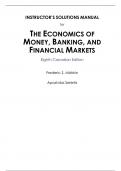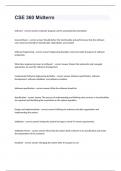INSTRUCTOR’S SOLUTIONS MANUAL for THE E CONOMICS OF MONEY, BANKING , AND FINANC IAL MARKETS
Eighth Canadian Editio n Frederic S. Mishkin Apostolos Serletis ii Copyright © 20 23 Pearson Canada Inc. Contents Chapter 1: Why Study Money, Banking, and Financial Markets? ................................ ................................ 1-1
Chapter 2: An Overview of the Financial System ................................ ................................ ......................... 2-1
Chapter 3: What Is Money? ................................ ................................ ................................ ........................... 3-1
Chapter 4: Understanding Interest Rates ................................ ................................ ................................ ....... 4-1
Chapter 5: The Behaviour of Interest Rates ................................ ................................ ................................ ... 5-1
Chapter 6: The Risk and Term Structure of Interest Rates ................................ ................................ ............ 6-1
Chapter 7: The Stock Market, the Theory of Rational Expectations, and Efficient Market Hypothesis ....... 7-1
Chapter 8: An Economic Analysis of Financial Structure ................................ ................................ ............. 8-1
Chapter 9: Economic Analysis of Financial Regulation ................................ ................................ ................ 9-1
Chapter 10: Banking Industry: Structure and Competition ................................ ................................ ........... 10-1 Chapter 11: Financial Crises ................................ ................................ ................................ .......................... 11-1 Chapter 12: Banking and the Management of Financial Institutions ................................ ............................. 12-1 Chapter 13: Risk Management with Financial Derivatives ................................ ................................ ........... 13-1 Chapter 14: Central Banks and the Bank of Canada ................................ ................................ ...................... 14-1 Chapter 15: The Money Supply Process ................................ ................................ ................................ ........ 15-1 Chapter 16: Tools of Monetary Policy ................................ ................................ ................................ .......... 16-1 Chapter 17: The Conduct of Monetary Policy: Strategy and Tactics ................................ ............................ 17-1 Chapter 18: The Foreign Exchange Market ................................ ................................ ................................ ... 18-1 Chapter 1 9: The International Financial System ................................ ................................ ........................... 19-1 Chapter 20: Quantity Theory, Inflation, and the Demand for Money ................................ ........................... 20-1 Chapter 21: The IS Curve ................................ ................................ ................................ .............................. 21-1 Chapter 22: The Monetary Policy and Aggregate Demand Curves ................................ ............................... 22-1 Chapter 23: Aggregate Demand and Supply Analysis ................................ ................................ ................... 23-1 Chapter 2 4: Monetary Policy Theory ................................ ................................ ................................ ............ 24-1 Chapter 2 5: The Role of Expectations in Monetary Policy ................................ ................................ ........... 25-1 Chapter 2 6: Transmission Mechanisms of Monetary Policy ................................ ................................ ......... 26-1 Appendix: Alternative Course Outlines ................................ ................................ ................................ ......... A-1 Mishkin and Serletis • Instructor’s Manual for The Economics of Money, Banking, and Financial Markets , 8Ce 1–1 Copyright © 2023 Pearson Canada Inc. Chapter 1 : Why Study Money, Banking, and Financial Markets? Chapter Overview and Teaching Tips Before embarking on a study of money, banking, and financial markets, the student must be convinced that this subject is worth studying. Chapter 1 pursues this goal in two ways. First, it shows the student that money and banking is an exciting field because it focuses on economic phenomena that affect everyday life. Second, using eight figures, this chapter encourages the student to look at data that bear on the central issues in this field. An additional purpose of Chapter 1 is to provide an overview for the entire book, previewing the topics that will be covered in later chapters, and to indicate how the book will be taught. In teaching this chapter, the most important goal should be to get the student excited about the material. We have found that talking about the data presented in the figures helps achieve this goal. Furthermore, it shows the student that the subject matter of money and banking has real -
world implications that the student should care about. The appendix to this chapter reviews concepts regarding the definitions of aggregate output , income , and the price level that the student already has seen in an economic principles course. Since these concepts are extremely important, it might be worthwhile to have your students read this appendix outside of class to jog their memories. Answers to End -of-Chapter Questions and Problems ANSWERS TO QUESTIONS 1. What is the typical relationship among interest rates on three -month Treasury bills, long -
term Canada bonds, and corporate bonds? The interest rate on three -month Treasury bills fluctuates more than the other interest rates and is lower on average. The interest rate on corporate bonds is higher on average than the other interest rates. 2. What effect might a fall in stock prices have on business investment? The lower price for a firm’s shares means that it can raise a smaller amount of funds, so investment in facilities and equipment will fall. 3. Explain the main difference between a bond and a common stock. A bond is a debt instrument, which entitles the owner to receive periodic amounts of money (predetermined by the characteristics of the bond) until its maturity date. A common stock, however, represents a share of ownership in the institution that has issued the stock. In Mishkin and Serletis • Instructor’s Manual for The Economics of Money, Banking, and Financial Markets , 8Ce 1–2 Copyright © 2023 Pearson Canada Inc. addition to its definition, it is not the same to hold bonds or stock of a given corporation, since regulations state that stockholders are residual claimants (i.e., the corporation has to pay all bondholders before paying stockholders). 4. Explain the link between well -performing financial markets and economic growth. Name one channel through which financial markets might affect economic growth and poverty. Well -performing financial markets tend to allocate funds to its more efficient use, thereby allowing the best investment opportunities to be undertaken. The improvement in the allocation of funds results in a more efficient economy, which stimulates economic growth (and thereby poverty reduction). 5. What was the main cause of the global financial crisis that began in 2007? The United States’ economy was hit by the worst financial crisis since the Great Depression. Defaults in subprime residential mortgages led to major losses in financial institutions, producing not only numerous bank failures but also the demise of two of t he largest investment banks in the United States. These factors led to the “Great Recession” that began late in 2007. 6. Can you think of a reason why people in general do not lend money to one another to buy a house or a car? How would your answer explain the existence of banks? In general, people do not lend large amounts of money to one another because of several information problems. In particular, people do not know about the capacity of other people to repay their debts or the effort they will make to repay their debts. Finan cial intermediaries, in particular commercial banks, tend to solve these problems by acquiring information about potential borrowers and writing and enforcing contracts that encourage lenders to repay their debt and/or maintain the value of the collateral. 7. What are the other important financial intermediaries in the economy, besides banks? Other important financial intermediaries are Trust and loan companies, credit unions, caisses populaires , insurance companies, mutual funds, pension funds, and finance companies. 8. Can you date the latest financial crisis in the United States or in Europe? Are there reasons to think that these crises might have been related? Why? The latest financial crisis in the United States and Europe occurred in 2007 –2009. At the beginning, it hit mostly the U.S. financial system, but it then quickly moved to Europe, since financial markets are highly interconnected. One specific way in which these markets were related is that some financial intermediaries in Europe held securities backed by mortgages originating in the United States, and when these securities lost a considerable part of their value, the balance sheet of European financial inte rmediaries was adversely affected.





